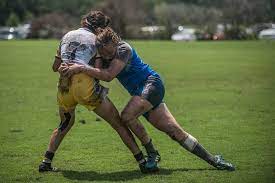Rugby is a sport that demands strength, agility, and endurance from its players. A crucial aspect of the game is the ability to drive forward with your legs to make progress up the field. A leg drive is a fundamental skill in rugby and can help players make powerful tackles, fend off defenders, and make powerful runs. In this article, we’ll explore what a leg drive is, how it works, and why it’s so important in rugby.
What is a Leg Drive?
A leg drive is a technique used by rugby players to generate power and momentum when making tackles, carrying the ball, or making runs. It involves using your legs to propel yourself forward, either with or without the ball, to gain ground and make progress up the field. The leg drive is an essential part of rugby, and it is used by players in many different positions, from forwards to backs.
How Does a Leg Drive Work?
The leg drive works by using your lower body to generate power and momentum. The key to a good leg drive is to use your hips and legs to generate as much force as possible. This can be done by keeping your knees bent, driving through your legs, and keeping your body in a low, balanced position. The more force you can generate with your legs, the more effective your leg drive will be.

Why is a Leg Drive Important in Rugby?
A leg drive is an essential part of rugby, as it gives players the power and momentum to make powerful tackles, fend off defenders, and make powerful runs. It’s also important for maintaining balance and stability, which is crucial in a sport like rugby, where players are often subjected to heavy tackles and impacts. The ability to drive forward with your legs can also help players evade tackles, make faster runs, and gain more ground.
How can I improve my leg drive
Here are a few tips to help improve your leg drive in rugby:
- Strength Training: Building strength in your legs and hips is crucial for a powerful leg drive. Focus on exercises such as squats, lunges, and deadlifts to build strength in your legs and hips.
- Plyometrics: Plyometric exercises such as jumping and bounding can help to improve your explosive power, which is essential for a strong leg drive.
- Speed Training: Improving your speed and agility can also help to improve your leg drive. Focus on drills that require quick acceleration and deceleration to develop your speed and agility.
- Technique: The key to a good leg drive is using your hips and legs to generate as much force as possible. Pay attention to your technique and focus on keeping your knees bent, driving through your legs, and keeping your body in a low, balanced position.
- Practise: The more you practise the leg drive, the better you will become. Practise making tackles and carrying the ball while focusing on using your legs to generate power and momentum.

Remember, improving your leg drive takes time and effort. It’s important to be consistent in your training and focus on building strength, speed, and technique. With dedication and practice, you will see improvements in your leg drive and become a more powerful and effective rugby player.
In conclusion, the leg drive is a fundamental skill in rugby, and it is essential for players who want to be successful on the field. Whether you’re a forward or a back, having a good leg drive will help you make powerful tackles, fend off defenders, and make powerful runs. So, work on your leg drive, and you’ll soon see the benefits on the field.
